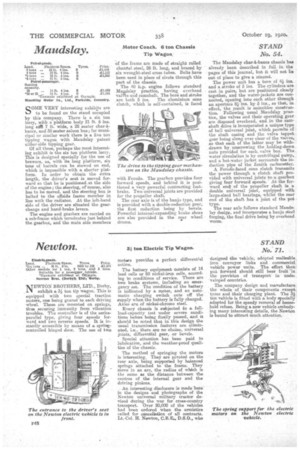Newton.
Page 56

If you've noticed an error in this article please click here to report it so we can fix it.
311, ton Electric Tip Wagon.
STAND No. 71.
ElsotrIc-goods.
Loan. Platform Space. Tyres. Price.
-ra,,e tons ... 1011. Gin. 5920 by 120 £1.570 Other models for 1 ton, 2 tons, and 5 tons.
Suitable for a passepger vehicle. *Example exhibited st Olympia. Newton Bros. (Derbyti ttrE) Merby.
MENVTON BROTHERS, LTD., Derby, .L1 exhibit a 3 ton tip wagon. This is equipped with two special traction motors, one being geared to each driving wheel. These are mounted on springs, thus securing immunity from vibration troubles. The controller is of the seriesparallel type, giving four speeds forward and two reverse speeds. It is instantly accessible by means of a springcontrolled hinged door. The use of two mots provides a perfect differential action.
The battery equipment consists of 14 lead cells or 60 nickel-iron cells, according to conditions of service. There are two brake systems, including an emergency set. The condition of the battery is indicated by a meter, and an automatic charging switch cute off the supply when the battery is fully charged. Axles are, of nickel-chrome steel. •
Every chassis is subjected fo a fullload-capacity test under severe cosidibons before -being finally passed, and it should be noted that in this design the usual transmission features are eliminated, i.e., there are no chains, universal joints, differential gear, or bevels.
Special attention has been paid to lubrication, and the weather-proof qualities of the chassis.
The method of springing the motors is interesting. They are pivoted on the rear axle, being supported by balanced springs attached to the frame. They move in an arc, the radius of which Is the same as the distance between the centres of the internal gear and the driving pinions.
An interesting disclosure is made here in the designs and photographs of the Newton universal military tractor devised during the war for cross-country transport. Over 20,000 of the vehicles had been ordered when the armistice called for cancellation of all contracts. Lt.-Col. H. Newton, C.B.E., D.S.O., who
• designed the vehicle, adopted malleable iron conveyor links and commercial vehicle power units. The effort their put forward should still bear fruit in the provision of transport in undeveloped countries.
The company design and manufacture the whole of their components except tyres and their charging plant. The 31ton vehicle is fitted with a body apecially adapted for the speedy removal of household refuse. Being a new vehicle embodying many interesting details, the Newton is bound to attract much attention.












































































